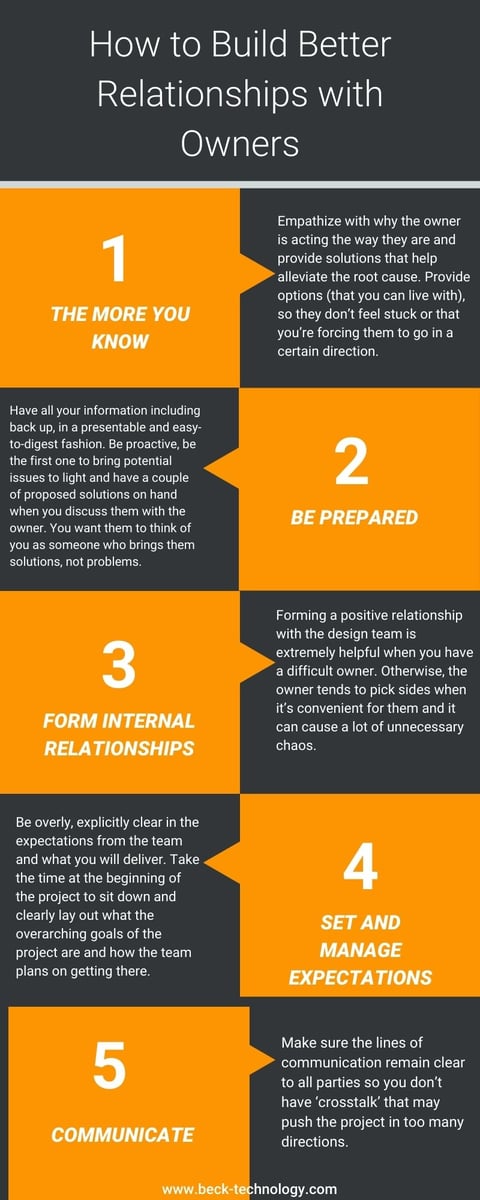5 Successful Ways to Deal with a Difficult Owner
Know-it-alls, the mind-changer, unrealistic expectations, or just down-right assholes… we’re fairly sure you’re no stranger to challenging owners. And since collaboration between design, operations, and owners isn’t just a trend, you’re having to deal with more people more often. We know that consistent communication with all involved in a project prevents change orders, budget overruns, and disappointed stakeholders; however, the more people involved, the better chance problems arise. (Add mediator to your list of skills, right?)
To keep building relationships with owners and maintain your reputation, you need to deal with a difficult owner with grace and professionalism.

The More You Know
Most difficulties arise due to an owner’s lack of understanding. Stacks of spreadsheets with a bunch of numbers on them are hard to prove and understand. No one ever wants to look stupid, so instead of expressing that they don’t get it, some people turn to anger and frustration.

When this is the case, it’s simple to mitigate. Explain the preconstruction process to the owner and provide them with all the information in an easy-to-understand way. Powerful data visualization software like Microsoft Power BI presents numbers in a way that is easily understood by owners.
Senior Implementation Kristin Vrana, who has a background in estimating says, “try to empathize with why the owner is acting the way they are and provide solutions that help alleviate the root cause. And continuously provide options (that you can live with), so they don’t feel stuck or that you’re forcing them to go in a certain direction.”
More information leads to better decisions, so the more your owner knows, the less likely they will request things you can’t deliver.
Be Prepared
Humans are hard-wired to act in their own self-interest. It’s a survival thing. Keep this in mind when it seems like an owner isn’t listening to you or is insisting on his way or the highway. There is a lot at stake, and he’s got pressure from the top just like you do.
One of an estimator’s superpowers is knowing where risk is. Before your preconstruction meeting, you and your team need to identify every possible problem that could arise in the plans. If you do this, you will already have all the solutions laid out to any of the owner’s objections. Anticipate push-back, questions, and complaints the owner could have about the architect’s design or any of the numbers you present.
Our own Lauren Senska, Implementation Specialist II, who came to Beck Technology from precon says, “…always be prepared–have all your information including back up, in a presentable and easy-to-digest fashion. Be proactive, be the first one to bring potential issues to light and have a couple of proposed solutions on hand when you discuss them with the owner. You want them to think of you as someone who brings them solutions, not problems.”
Form Internal Relationships
The days of design handing over a bunch of drawings and walking away are over. Collaboration is the new design-bid-build. If your internal team is working against each other, what do you think this looks like to the owner? You’ll appear untrustworthy, discombobulated, and not experienced in solving problems. Kristin says, “…forming a positive relationship with the design team is extremely helpful when you have a difficult owner. Otherwise, the owner tends to pick sides when it’s convenient for them and it can cause a lot of unnecessary chaos.”

It might seem obvious, but we can't overstate it enough: the precon team's relationship. with each other is also vitally important. You can’t work in silos and have an accurate estimate. With estimating software like DESTINI Estimator, every estimator can work on the same estimate at the same time with changes reflected in real-time. There is no excuse for not having the most up-to-date information.
John Reich, Beck Technology Customer Success Specialist with a long history in preconstruction says, “Nothing can derail a project faster than when an owner asks the dreaded “how much will this cost?” and someone shoots an answer from the hip without knowing the full story. Ask for time to give an educated answer. If you have to give an immediate answer, make sure that the right person is giving the answer and that it is something you can live with.”
Set and Manage Expectations
You are setting precon meetings, right? This is the perfect time to set expectations for everyone involved in the project. Communicating upfront is a sure-shot way of keeping everyone aligned throughout the project.
John says:
Be overly, explicitly clear in the expectations from the team and what you will deliver. Take the time at the beginning of the project to sit down and clearly lay out what the overarching goals of the project are and how the team plans on getting there.
When an owner says they need a drawing, ask the extra question to make sure they define whether a drawing is a rendering, a sketch, a floor plan, etc. If a team needs an estimate, find out what level of detail (i.e., total cost only, summary info, detailed estimate) and what they will be doing with that information so you can cater your efforts to achieve the team’s goal rather than what you think is the answer.
Sometimes, the extra 30 minutes at the beginning to properly define this can save days of effort that may or may not be really needed. Most of the time, a “difficult” owner is one who doesn’t understand what they are asking for.
Communicate, Communicate, Communicate

We cannot stress the importance of communication enough. Communicate early and often. Kristin suggests picking up the phone instead of sending an email or Teams message to schedule the precon meeting as “it’s much easier for negativity to spiral over email/text,” she says.
John goes as far as suggesting dedicating someone on the team to manage the client and the design team. He says, “This can be a full-time job but can build the relationship and trust to keep the project moving along. Make sure the lines of communication remain clear to all parties so you don’t have ‘crosstalk’ that may push the project in too many directions. And when you find something that is out of line with the expectations (high cost, lower cost, bigger, smaller, good, or bad) raise your hand and make sure the team hears about it BEFORE you spend several days working on it. A quick phone call saying “Hey, this is different than what we discussed” can sometimes correct a small issue before it becomes a major one.”
Another great tidbit from Natalie Muñoz, Beck Tech Training Specialist, who spent time in the field and as an estimator says to have your communication in writing, as well. She says to take “very thorough meeting minutes (that are sent to all invitees), email chains, if it is a phone or in-person conversation, write a “per our conversation…” email. Make sure all interactions and especially any decisions are documented thoroughly in writing. This usually eliminates any he said/she said situations, or if they don’t remember or misremember or get it mixed up with another project. You have it there in writing that it was sent to them on such-such a date and time, and they didn’t disagree or have an issue. And this goes for all interactions with owners, architects, and subs.”
With all that being said, don’t take an owner’s bad behavior personally and always respond calmly and with professionalism. It’s okay to call out an owner when they cross the line between gruff and flat-out offensive, but don’t fight fire with fire.
And John leaves us with great advice: “Expect change. Something will come up that can throw the project into complete disarray if the team lets it. Treat every potential roadblock as an opportunity to show how good your team is. When an opportunity like this comes up, don’t let the team fall into negativity. Try to find a positive spin on things and motivate the team to exceed expectations.”
How do you deal with difficult owners? Send us an email and let us know: info@beck-technology.com

-1.png?width=112&height=112&name=image%20(4)-1.png)














